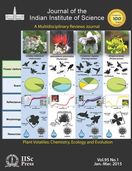Junker Group: Publications
Citations at google scholar
[44] Bacteria colonising Penstemon digitalis show volatile and tissue-specific responses to natural concentration range of floral volatile linalool. Burdon RCF, Junker RR, Scofield DG, Parachnowitsch AL (in press) Chemoecology
[43] Elevation predicts the functional composition of alpine plant communities based on vegetative traits, but not based on floral traits. Junker RR, Larue-Kontić A-AC (in press) Alpine Botany
[42] A biosynthetically informed distance measure to compare secondary metabolite profiles. Junker RR (in press) Chemoecology
[41] Epiphytic bacteria alter floral scent emissions. Helletsgruber C, Dötterl S, Ruprecht U, Junker RR (in press) Journal of Chemical Ecology
[40] Exotic flower visitors exploit large floral trait spaces resulting in asymmetric resource partitioning with native visitors. Kuppler J, Höfers M, Trutschnig W, Bathke AC, Eiben J, Daehler CC, Junker RR (in press) Functional Ecology
[39] Epiphytic bacteria on lettuce affect the feeding behavior of an invasive pest slug. Peters B, Türke M, Junker RR (in press) Acta Agrobotanica (invited contribution to a special issue on plant-animal interactions)
[38] Co-variation and phenotypic integration in chemical communication displays: biosynthetic constraints and eco-evolutionary implications. Junker RR, Kuppler J, Amo L, Blande J, Borges R, van Dam N, Dicke M, Dötterl S, Ehlers B, Etl F, Gershenzon J, Glinwood R, Gols R, Groot A, Heil M, Hoffmeister M, Holopainen J, Jarau S, John L, Kessler A, Knudsen J, Kost C, Larue-Kontic A-AC, Leonhardt S, Lucas-Barbosa D, Majetic C, Menzel F, Parachnowitsch A, Pasquet R, Poelman E, Raguso RA, Ruther J, Schiestl F, Schmitt T, Tholl D, Unsicker S, Verhulst N, Visser M, Weldegergis B, Koellner TG (in press) New Phytologist
[37] Volatility of network indices due to undersampling of intraspecific variation in plant insect interactions. Kuppler J, Grasegger T, Peters B, Popp S, Schlager M, Junker RR (in press) Arthropod-Plant Interactions
[36] Bumblebees require visual pollen stimuli to initiate and multimodal stimuli to complete a full behavioral sequence in close-range flower orientation. Wilmsen S, Gottlieb R, Junker RR, Lunau K (in press) Ecology and Evolution
[35] Biological invasions and ant-flower networks on islands. Blüthgen N, Kaiser-Bunbury CN, Junker RR (in press) In: Oliveira PS, Koptur S. Ant-Plant Interactions: Impacts of Humans on Terrestrial Ecosystems. Cambridge University Press (invited contribution)
[34] Herbivory-induced changes in the olfactory and visual display of flowers and extrafloral nectaries affect pollinator behavior. Hoffmeister M, Junker RR (in press) Evolutionary Ecology (invited contribution to a special issue on plant-animal communication)
[33] Dynamic range boxes – A robust non-parametric approach to quantify size and overlap of n-dimensional hypervolumes. Junker RR, Kuppler J, Bathke AC, Schreyer ML, Trutschnig W (2016) Methods in Ecology and Evolution DOI: 10.1111/2041-210X.12611
[32] Inhibition of biochemical terpene pathways in Achillea millefolium flowers differently affects the behavior of bumblebees (Bombus terrestris) and flies (Lucilia sericata). Larue-Kontić A-AC, Junker RR (2016) Journal of Pollination Ecology 18: 31-35
[31] Time-invariant differences between plant individuals in interactions with arthropods correlate with intraspecific variation in plant phenology, morphology and floral scent. Kuppler J, Höfers MK, Wiesmann L, Junker RR (2016) New Phytologist 210: 1357-1368
[30] Multifunctional and diverse floral scents mediate biotic interactions embedded in communities. Junker RR (2016) In: Blande JD, Glinwood RT (eds.) Deciphering chemical language of plant communication. Signaling and communication in plants. Springer Heidelberg. (invited contribution to a book on plant communication)
[29] Herbivore-induced changes in flower scent and morphology affect the structure of flower-visitor networks but not plant reproduction. Hoffmeister M, Wittköpper N, Junker RR (2016) Oikos 125: 1241-1249
[28] Experimental manipulation of floral scent bouquets restructures flower-visitor interactions in the field. Larue A-AC, Raguso RA, Junker RR (2016) Journal of Animal Ecology 85: 396-408 [highlighted by the Journal of Animal Ecology with an In Focus article by Peter A. Hambäck]
[27] Bees, birds and yellow flowers: Pollinator-dependent convergent evolution of UV-patterns. Papiorek S, Junker RR, Alves-dos-Santos I, Melo GAR, Amaral-Neto LP, Sazima M, Wolowski M, Freitas L, Lunau K (2016) Plant Biology 18: 46-55
[26] CYP76C1-mediated linalool metabolism and formation of volatile and soluble linalool oxides in Arabidopsis flowers, a strategy for defense against floral antagonists. Boachon B, Junker RR, Miesch L, Bassard J-E, Höfer R, Caillieaudeaux, R, Seidel DE, Lesot A, Heinrich C, Ginglinger J-F, Allouche L, Vincent B, Wahyuni DSC, Paetz C, Beran F, Miesch M, Schneider B, Leiss K, Werck-Reichhart D (2015) The Plant Cell 27: 2972–2990
[25] Microhabitat heterogeneity across leaves and flower organs promotes bacterial diversity. Junker RR, Keller A (2015) FEMS Microbiology Ecology 91: fiv097
[24] Working towards a holistic view on flower traits – How floral scents mediate plant-animal interactions in concert with other floral characters. Junker RR, Parachnowitsch AL (2015) Journal of the Indian Institute of Science 95: 43-67 (invited contribution to a special issue on plant volatiles)
[23] Functional and phylogenetic diversity of plant communities differently affect the structure of flower-visitor interactions and reveal convergences in floral traits. Junker RR, Blüthgen N, Keller A (2015) Evolutionary Ecology 29: 437-450 (invited contribution to a special issue on exploitation barriers)
[22] Prior exposure to DEET interrupts positive and negative responses to olfactory cues in Drosophila melanogaster. Junker RR, Klupsch K, Paulus J (2015) Journal of Insect Behavior 28: 1-14
[21] Gloss, colour and grip: Multifunctional epidermal cell shapes in bee- and bird-pollinated flowers. Papiorek SE, Junker RR, Lunau K (2014) PLoS ONE 9(11): e112013.
[20] The potential for indirect effects between co-flowering plants via shared pollinators depends on resource abundance, accessibility and relatedness. Carvalheiro LG, Biesmeijer JC, Benadi G, Fruend J, Stang M, Bartomeus I, Kaiser-Bunbury C, Baude M, Gomes S, Merckx V, Baldock K, Bennett A, Boada R, Bommarco R, Cartar R, Chacoff N, Danhardt J, Dicks L, Ekroos J, Henson K, Holzschuh A, Junker RR, Lopezaraiza-Mikel M, Memmott J, Montero-Castaño A, Nelson I, Petanidou T, Power E, Rundlöf M, Smith H, Stout J, Temitope K, Tscharntke T, Tscheulin T, Vila M, Kunin WE (2014) Ecology Letters 17: 1389–1399
[19] New Synthesis – A holobiontic view on plant-insect interactions. Junker RR (2014) Journal of Chemical Ecology, 40:521 (invited commentary)
[18] Density-dependent negative responses by bumblebees to bacteria isolated from flowers. Junker RR, Romeike T, Keller A, Langen D (2014) Apidologie, 45:467-477
[17] Urban biodiversity hotspots wait to get discovered: The example of the city of Ioannina, NW Greece. Kantsa A, Tscheulin T, Junker RR, Petanidou T, Kokkini S (2013) Landscape and Urban Planning doi: 10.1016/j.landurbplan.2013.08.013 [highlighted by the European Commission]
[16] Volatile organic compound mediated interactions at the plant-microbe interface. Junker RR, Tholl D (2013) Journal of Chemical Ecology, 39: 810-825 (invited contribution to a special issue on Microbial Chemical Ecology)
[15] Salience of multimodal flower cues manipulates initial responses and facilitates learning performance of bumblebees. Katzenberger TD, Lunau K, Junker RR (2013) Behavioral Ecology and Sociobiology doi: 10.1007/s00265-013-1570-1
[14] Specialisation on traits as basis for the niche-breadth of flower visitors and as structuring mechanism of ecological networks. Junker RR, Blüthgen N, Brehm T, Binkenstein J, Paulus J, Schaefer HM, Stang M (2013) Functional Ecology, 27: 329-341
[13] Floral odour bouquet loses its ant repellent properties after inhibition of terpene biosynthesis. Junker RR, Gershenzon J, Unsicker SB (2011) Journal of Chemical Ecology, 37:1323–1331
[12] Sampling forest canopy arthropod biodiversity with three novel minimal-cost trap designs. Bar-Ness YD, McQuillan PB, Whitman M, Junker RR, Cracknell M, Barrows A (2011) Australian Journal of Entomology, 51:12-21
[11] Composition of epiphytic bacterial communities differs on petals and leaves. Junker RR, Loewel C, Gross R, Dötterl S, Keller A, Blüthgen N (2011) Plant Biology, 13: 918-924
[10] Phytochemical cues affect hunting site choices of a nursery web spider (Pisaura mirabilis) but not of a crab spider (Misumena vatia). Junker RR, Bretscher S, Dötterl S, Blüthgen N (2011) Journal of Arachnology 39:113-117
[9] Ant-plant mutualism in Hawai’i? Invasive ants reduce flower parasitism but also exploit floral nectar of the endemic shrub Vaccinium reticulatum (Ericaceae). Bleil R, Blüthgen N, Junker RR (2011) Pacific Science 65 (3) 291-300
[8] Ant-flower networks in Hawai’i: nectar-thieving ants prefer undefended native over introduced plants with floral defenses. Junker RR, Daehler CC, Dötterl S, Keller A, Blüthgen N (2011) Ecological Monographs, 81: 295-311
[7] Intrafloral resource partitioning between endemic and invasive flower visitors: consequences for pollinator effectiveness. Junker RR, Bleil R, Daehler C, Blüthgen N (2010) Ecological Entomology 35: 760-767
[6] Responses to olfactory signals reflect network structure of flower-visitor interactions. Junker RR, Höcherl N & Blüthgen N (2010) Journal of Animal Ecology 79: 818-823
[5] Floral scents repel facultative flower visitors, but attract obligate ones. Junker RR & Blüthgen N (2010) Annals of Botany 105: 777-782 (see also: invited article addendum in Plant Signaling and Behavior)
[4] Floral scent terpenoids deter the facultative florivore Metrioptera bicolor (Ensifera, Tettigoniidae, Decticinae). Junker RR, Heidinger IMM & Blüthgen N (2010) Journal of Orthoptera Research 19: 69-74
[3] Feeding preferences of phasmids in a Bornean dipterocarp forest. Junker RR, Itioka T, Bragg PE & Blüthgen N (2008) Raffles Bulletin of Zoology 56: 235-242
[2] Floral scents repel potentially nectar-thieving ants. Junker RR & Blüthgen N (2008) Evolutionary Ecology Research 10: 295-308
[1] Interaction between flowers, ants and pollinators: additional evidence for floral repellence against ants. Junker R, Chung AYC & Blüthgen N (2007) Ecological Research 22: 665-670
Manuscripts refereed for Acta Oecologia, African Journal of Bacteriological Research, Animal Cognition, Arthropod-Plant Interactions, Australian Journal of Entomology, Biology Letters, Biological Reviews, Biotropica, Chemoecology, Conservation Biology, Current Opinion in Plant Science, Diversity and Distributions, Ecological Entomology, Ecosphere, Environmental Science and Pollution Research, Evolutionary Ecology, FEMS Microbiology Ecology, Flora, Functional Ecology, Fungal Ecology, Global Ecology and Biogeography, Journal of Animal Ecology, Journal of Chemical Ecology, Journal of Ecology, Journal of Insect Behavior, Journal of Plant Ecology, Journal of Pollination Ecology, Journal of Visualized Experiments, Molecular Ecology, Nature Climate Change, Naturwissenschaften, New Phytologist, Oecologia, Oikos, Pacific Science, Perspectives in Plant Ecology, Evolution and Systematics, Plant Biology, Plant Signaling and Behavior, PLoS Biology, PLoS ONE, Proceedings of the Royal Society B, Psyche, The ISME Journal.
Not peer-reviewed publication:
Dependency on floral resources determines the animals’ responses to floral scents. Junker RR & Blüthgen N (2010) Plant Signaling and Behavior 5: 1014-1016
Blütendüfte in doppelter Mission. Junker RR & Blüthgen N (2009) Deutsches Bienen Journal 2: 34
Conference contributions:
Robert R. Junker (2015) Floral microbial ecology: VOCs as potential mechanism causing microhabitat heterogeneity in bacterial colonisation patterns in flowers. Invited talk at the International Society of Chemical Ecology meeting, Sweden
Rosalie Burdon, Robert Gegear, Robert R. Junker, Andre Kessler, Amy Parachnowitsch (2015) Functional role of the floral volatile, S-(+)-linalool, in Penstemon digitalis. Talk at the International Society of Chemical Ecology meeting, Sweden
Birte Peters, Manfred Türke, Robert R. Junker (2015) The influence of bacterial communities colonizing lettuce (Lactuca sativa) on foraging decisions of slugs (Arion vulgaris). Poster at the International Society of Chemical Ecology meeting, Sweden
Robert R. Junker, Jonas Kuppler, James Blande, Marcel Dicke, Stefan Dötterl, Bodil Ehlers, Thomas Eltz, Jonathan Gershenzon, Robert Glinwood, Rieta Gols, Mathias Hoffmeister, Stefan Jarau, Andre Kessler, Jette Knudsen, Anne-Amélie C. Larue, Sara D. Leonhardt, Dani Lucas Barbosa, Florian Menzel, Amy Parachnowitsch, Rocio Perrez-Barrales, Anne Plotto, Eric Poelman, Robert A. Raguso, Florian Schiestl, Thomas Schmitt, Dorothea Tholl, Sybille Unsicker, Nicole van Dam, Niels Verhulst, Ben Webster, Berhane Weldegergis, Tobias Köllner (2015) Co-variation in scent bouquets: biochemical constraint or meaningful pattern for communication? Poster at the International Society of Chemical Ecology meeting, Sweden
Junker RR, Larue A-AC, Wiesmann L (2014) The functional diversity of floral and vegetative traits along an altitudinal gradient suggests that habitat filtering and competition avoidance additively act on plant community assembly. Talk at the SCAPE meeting, Sweden
Kuppler J, Höfers M, Eiben JA, Trutschnig W, Bathke A, Daehler C, Junker RR (2014) Infiltrated by invaders: a trait-based community approach for understanding niche competition of flower-visitors in the Hawaii Volcanoes National Park. Talk at the SCAPE meeting, Sweden
Junker RR (2014) Floral microbial ecology – bacterial colonization is controlled by and alters floral scent composition. Talk at the GfÖ meeting in Hildesheim, Germany
Larue A-AC, Junker RR (2014) Functional diversity of flower signals along an altitudinal gradient under consideration of the sensory physiology of flower visitors. Talk at the GfÖ meeting in Hildesheim, Germany
Kuppler J, Höfers M, Wiesmann L, Junker RR (2014) Ecological significance of intra-specific trait variation on individual plant fitness. Talk at the 99th Annual Meeting of the Ecological Society of America (ESA) in Sacramento, USA
Junker RR, Keller A (2014) Volatile organic compounds in floral microbial ecology. Poster at the Gordon Research Conference on Plant Volatiles, Ventura, USA
Larue A-AC, Junker RR (2014) Multifunctionality of floral scent bouquets revealed by inhibition of pathway-specific products. Poster at the Gordon Research Conference on Plant Volatiles, Ventura, USA
Larue A-AC, Junker RR (2014) Multifunctionality of floral scent bouquets revealed by inhibition of pathway-specific products. Invited talk at the Gordon Research Seminar on Plant Volatiles, Ventura, USA
Junker RR (2013) Phylogenetic and functional diversity in plant communities and individuals. Talk at the SCAPE meeting in Lammi Biological Station, Finland
Hoffmeister M, N Wittköpper, RR Junker (2013) Consequences and dynamic of herbivory as source for variation in flower traits. Talk at the SCAPE meeting in Lammi Biological Station, Finland
Kuppler J, RR Junker (2013) A lifetime interaction network – linking the intraspecific variability in functional plant traits, interactions and plant reproduction. Talk at the Symposium on Ecological Networks in Coimbra, Portugal
Junker RR (2013) (Induced) intraspecific variation in functional plant traits affects interacting communities at flowers and leaves. Talk at the GfÖ meeting in Postdam, Germany
Anne-Amélie C. Larue, Robert A. Raguso, Robert R. Junker (2012) Bees choose benzenoids, flies prefer terpenoids: floral scent bouquets determine flower visitor composition. Poster at the Frontiers of Chemical Ecology Workshop, Jena, Germany
Hoffmeister M, Junker RR (2012) Negative effects of herbivore-induced changes in floral scent bouquets on pollinator behavior are compensated by visual traits. Poster at the Frontiers of Chemical Ecology Workshop, Jena, Germany
Junker RR (2012) Invisible flower visitors – diversity, distribution and potential functions of epiphytic bacteria colonising flowers.Talk at the SCAPE meeting on the island Kirkøy, Norway
Anne-Amélie C. Larue, Robert R. Junker (2012) Augmentation of floral scent bouquets – the effect of volatiles on partitioning of flower-visitors. Poster at the SCAPE meeting on the island Kirkøy, Norway
Hoffmeister M, Schlautmann J, Junker RR (2012) Corrupted communication – Do herbivores affect plant-insect interactions? Talk at the SCAPE meeting on the island Kirkøy, Norway
Kuppler J, Perez-Barrales R & Junker RR (2012) Inferring from variation and covariation of leaf, flower, and seed traits to the evolution of plant-arthropod interactions. Poster at the SCAPE meeting on the island Kirkøy, Norway
Hoffmeister M, Junker RR (2012) Herbivore-induced changes in floral traits and pollinator behavior – Contrasting effects of olfactory and visual signals? Poster at the Multitrophic Interaction Workshop in Göttingen, Germany
Junker RR (2012) Multifunctionality and variability of flower scents and their potential as floral filters. Invited talk at the Gordon Research Conference on Plant Volatiles in Ventura, USA
Hoffmeister M, Junker RR (2012) Herbivore-induced changes in floral traits and pollinator behavior – Contrasting effects of olfactory and visual signals? Poster at the Gordon Research Conference on Plant Volatiles in Ventura, USA
Hoffmeister M, Junker RR (2011) Herbivore-induced changes in floral traits: Ecological costs or benefits? Poster at the SCAPE meeting in Bredsten, Denmark
Junker RR (2011) Blütendüfte: Attraktiv für Bestäuber und abschreckend für Nektarräuber, Pollendiebe und Co. Invited talk at the 24. Westdeutscher Entomologentag, Düsseldorf, Germany
Junker RR, Gershenzon J, Unsicker S (2011) Floral Filters – Floral odour composition loses ability to repel ants after inhibition of terpene-biosynthesis. Talk at the Deutsche Gesellschaft für allgemeine und angewandte Entomolgie (DGaaE) meeting in Berlin, Germany
Junker RR, Brehm T, Binkenstein J, Blüthgen N, Paulus J, Stang M (2010) Which flower traits explain visitors’ choices? A multivariate approach. Poster at the SCAPE meeting in Tovetorp, Sweden
Junker RR, Daehler C, Bleil R, Blüthgen N (2010) Defensive floral traits shape ant-flower networks in Hawai’i: Patterns and consequences for endemic species. Talk at the 95th Annual Meeting of the Ecological Society of America (ESA) in Pittsburgh, USA
Junker RR, Bleil R, Daehler C, Blüthgen N (2010) Invasive ants as flower visitors in Hawai’i: patterns, explanations, and unexpected consequences. Talk at the Multitrophic Interactions Workshop in Göttingen, Germany
Junker RR, Daehler C, Blüthgen N (2009) Alien ants on alien plants? What determines the distribution of nectar-feeding ants on flowers in Hawaii? Talk at the SCAPE meeting in Seili, Finland
Junker RR, Blüthgen N (2009) Floral volatile defences against unbidden guests. Poster and invited talk at the Gordon Research Conference on Floral and Vegetative Volatiles in Oxford, UK
Junker RR, Blüthgen N (2008) Scents as floral filters: the challenge to attract and defend. Talk at the SCAPE meeting in Kaupanger, Norway
Junker RR, Blüthgen N (2008) Floral traits as defensive traits against antagonists. Talk at the 93rd Annual Meeting of the Ecological Society of America (ESA) in Milwaukee, USA
Junker RR, Blüthgen N (2008) Attraction and defence: A different view on floral scents. Poster at the “The Ecology and Evolution of Plant-Pollinator Interactions” Conference in Milwaukee, USA
Junker RR, Blüthgen N (2008) Floral scents are not only attractive signals. Talk at the Multitrophic Interactions Workshop in Göttingen, Germany
Junker R, Blüthgen N (2005) Do flowers repel ants? A comparative study in a Bornean rainforest. Poster at the 4th International Canopy Conference in Leipzig, Germany
back to Junker group





